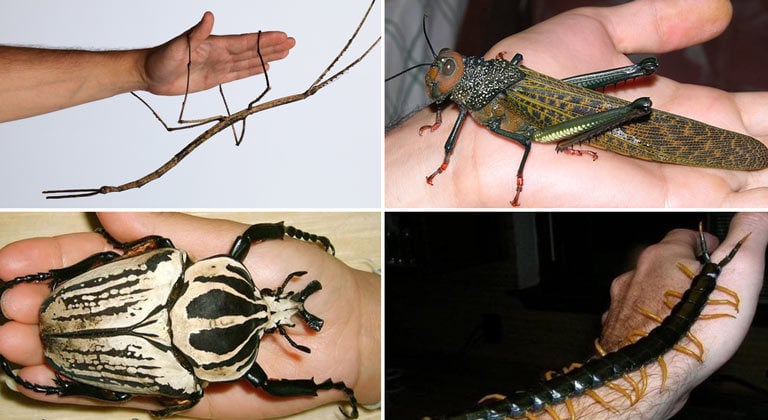The largest group of insects that ever existed are the Meganisoptera (commonly but incorrectly referred to as Protodonata) or Griffenflies. They were predatory flying insects with wingspan of 12 – 75 cm. Like dragonflies, to which they were related, they had long narrow bodies, huge eyes, and strong jaws and spiny legs for grasping prey. Thankfully though, it can be assumed that they evolved some time during the mid Carboniferous, flourished until the end of the Paleozoic.
In today’s world though, there are a few that are nevertheless large enough to give even seasoned entomologists a good fright.
1. Phryganistria chinensis Zhao: 62.4 cm (24.6 in) – the largest insect on Earth.

The stick insects (also known by many other names, including walking sticks, leaf insects, and ghost insects) are a vast order of insects that consists of than 3,000 species, almost all of them characterized by a spindly, flat, tube-like appearance. They have evolved the ability to hide from predators by blending in with the very branches and leaves they resemble. Some even wield lichen or mossy outgrowth to make the camouflage appear extra convincing.
Most species of stick insects measures at least a foot long. The longest of all stick insects (and insects in general) is a species called Phryganistria chinensis. First discovered in China in 2016, it can reach 25 inches long, or about the size of that ancient dragonfly. The next two largest stick insect species measure about 22 inches. Despite their impressive length, however, the stick insect’s flat, tube-shaped body means that they weigh only a fraction of what you’d expect.
2. Goliath Beetle
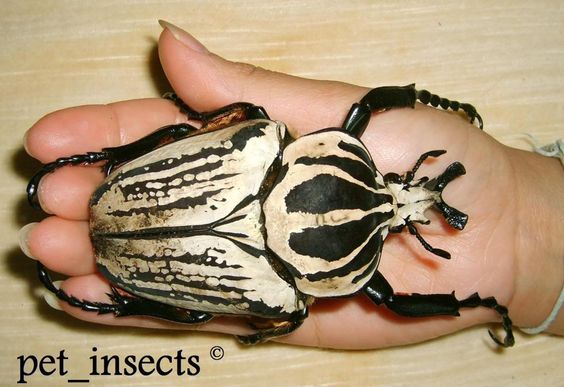
Based on weight and bulk, goliath beetles are strong contenders for the title of largest insects on Earth. Native to Africa, males of these species can grow to over 4 inches, and can weigh as much as 100 grams (3.5 ounces) in their larval stage.
Though they are believed to be primarily vegetarian in the wild, they have shown a voracious appetite for protein in captivity, and captive beetles are often fed dog and cat food.
3. Giant Weta
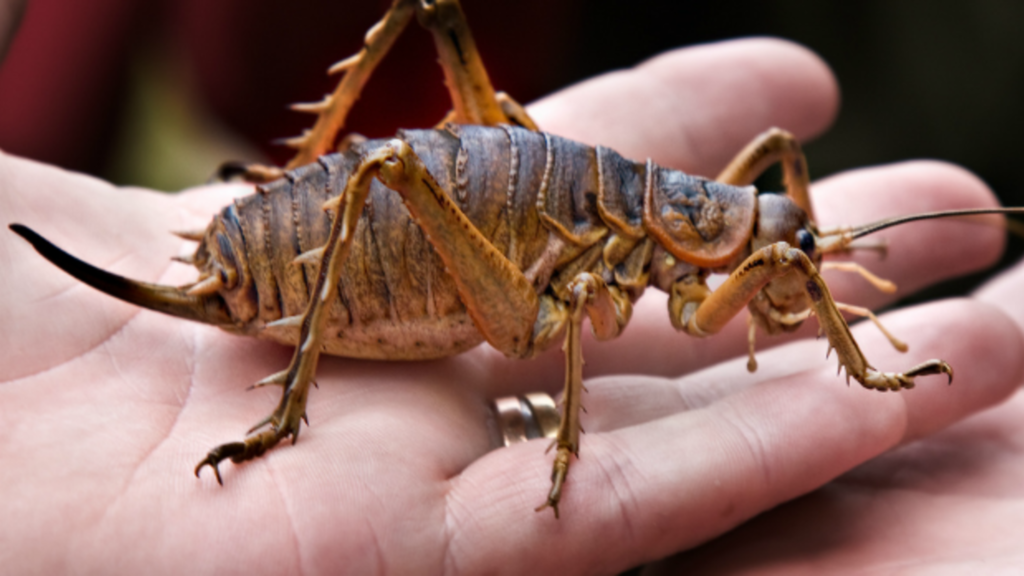
Giant weta are several species of weta in the genus Deinacrida of the family Anostostomatidae. Giant weta are endemic to New Zealandand are examples of island gigantism. There are eleven species of giant weta, most of which are larger than other weta, despite the latter already being large by insect standards. Large species can be up to 10 cm (4 in) not inclusive of legs and antennae, with body mass usually no more than 35 g. The largest species of giant weta is the Little Barrier Island giant weta, also known as the wetapunga. One example reported in 2011 weighed 71 g, and a 72 g specimen has been recorded.
4. Giant Burrowing Cockroach
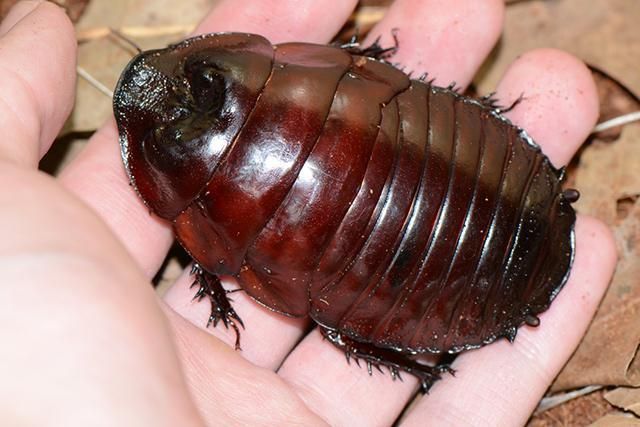
The Giant Burrowing Cockroach is the world’s heaviest cockroach, weighing up to 30 grams and reaching 7.5 cm in length. These smooth, shiny brown cockroaches never have wings and live in permanent burrows in the soil where females care for their young. These native Australians occur in open forests in northern Queensland and are important recyclers. Giant Burrowing Cockroaches can be bought and kept as pets for up to 10 years. They use their stout, spiny legs to dig burrows up to a meter deep in the soil, with a chamber at the end. At night they come to the surface and forage for dry leaves, taking some down the burrow for food. The female bears up to 30 live young at a time which remain in the burrow with their mother for some time. The nymphs moult 10 to 12 times before reaching full size.
Length up to 75 mm. Dark brown with a broad heavy body and very stout spiny legs. Males and females differ in the shape of the front of the thorax which is more deeply indented like a shovel in males.
5. Atlas Moth
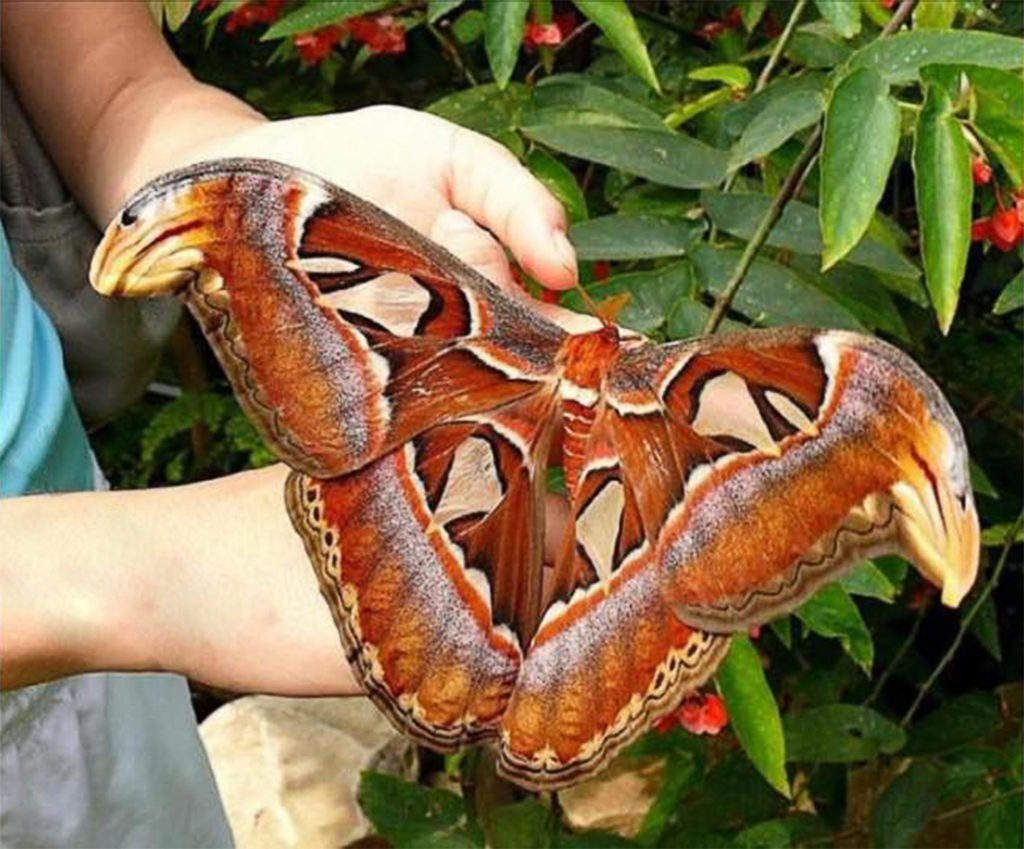
One of the goliaths of the insect world, the atlas moth is a gentle giant – but behind every oversized moth is a very hungry caterpillar. The atlas moth is among the biggest insects on the planet, with a wingspan stretching up to 27 centimetres across – that’s wider than a human handspan. And the caterpillars of the species reach up to 12 centimetres long, spending every spare second eating. Luke Brown, manager of the Museum’s butterfly house, says, ‘It is impossible not to be fascinated by the atlas moth. This is due to its beauty, the detail on its wings, and its sheer size at every stage of its life cycle.’
Adult atlas moths may be massive, but they do not feed at all after they have emerged from the cocoon. The proboscis, which other butterflies and moths use to drink nectar, is tiny and does not work. Without the ability to feed, atlas moths only manage between one and two weeks of life before the energy to power their huge wings runs out.
6. Titan Beetle
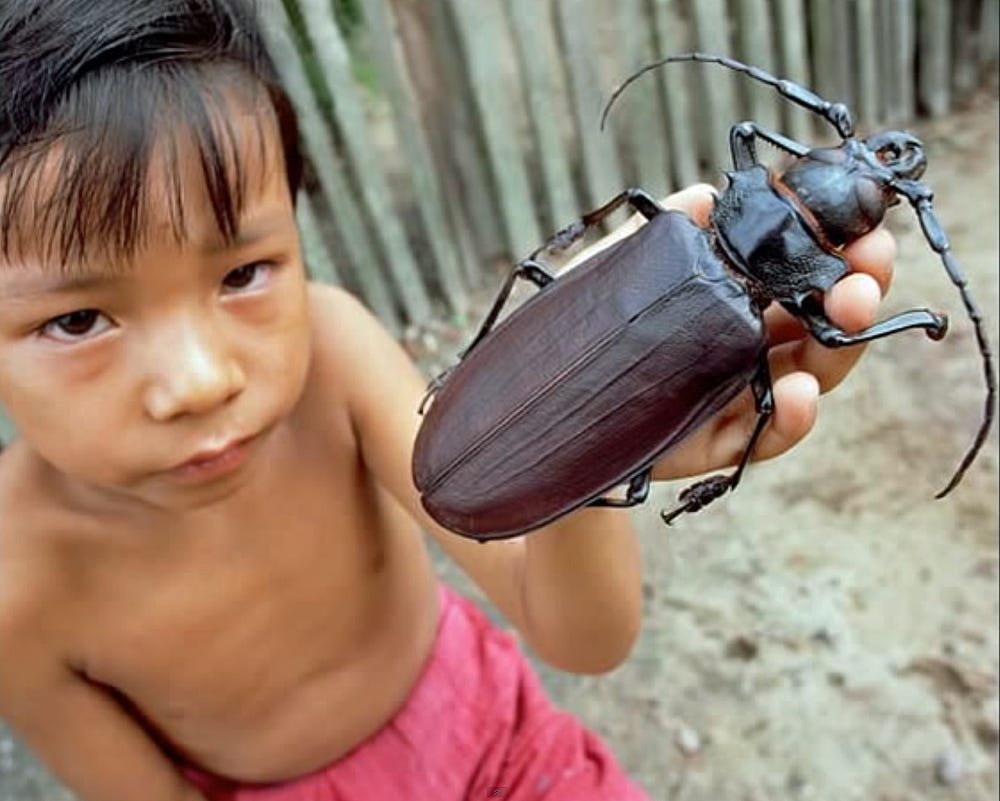
The titan beetle (Titanus giganteus) is the largest known beetle in the Amazon rain forest and one of the largest insect species in the world. It typically lives in the rain forests of Colombia, Ecuador, Peru, Bolivia, the Guianas and north-central Brazil. Adult titan beetles can grow up to 6.5 inches in length. They defend themselves against predators by using their sharp spines and strong jaws. It is said that their mandibles can snap pencils in half and cut into human flesh.
Like many large adult insects, titan beetles locate mates by flight and sensing air chemicals (pheromones).
7. Tarantula Hawks

Armed with one of the most painful stings on the planet, tarantula hawks are a spider’s worst nightmare. A fear of insects is common among humans, but for some spiders, stings really can be a matter of life or death. One wasp in particular makes even the biggest, hairiest spider run away in terror: the tarantula hawk.
Despite their name, tarantula hawks (Pepsis genus) are actually a species of spider wasp. Reaching up to 11 centimetres in length, these insects lead solitary lives and their 133 known species are found across South and Central America and in the southern United States. They are named after their habit of hunting tarantulas, which are often considerably larger than themselves – but these wasps do so with little risk to their own lives.
The wasps always win. The spiders will usually try to flee or avoid them at all costs.
8. Queen Alexandra’s Birdwing
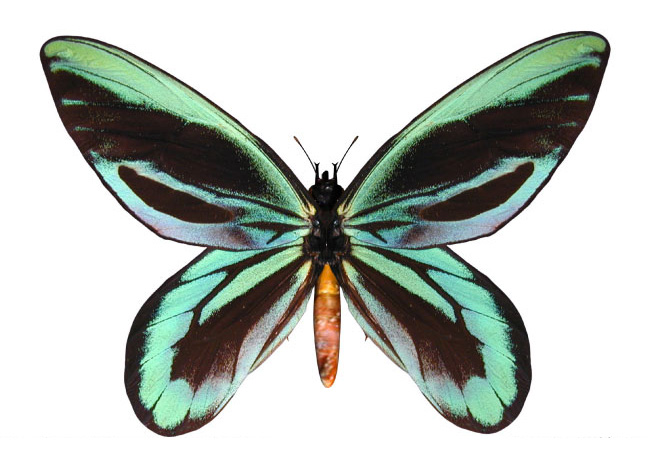
The Queen Alexandra’s birdwing (Ornithoptera alexandrae) is the largest butterfly in the world. Found only in remote regions of Papua New Guinea, the species was discovered in 1906, and the first specimen ever found was taken down using a shotgun. Females are slightly larger than males, with wingspan approaching and even exceeding 10 to 11 inches. Males tend to have wingspans that range from 6 to 8 inches. Furthermore, the body of a female Queen Alexandra’s birdwing can measure slightly more than 3 inches long.
The species is highly prized by butterfly collectors due to its rarity and status as the world’s largest butterfly, and single specimens can fetch prices of several thousand dollars on the black market. While poaching poses a slight threat to the survival of this species, habitat destruction is an even more significant threat, as the forests where the Queen Alexandra’s birdwing lives are increasingly cut down to make room for oil palm, cocoa, and rubber plantations, forcing the IUCN to list the butterfly as endangered.
9. Actaeon Beetle
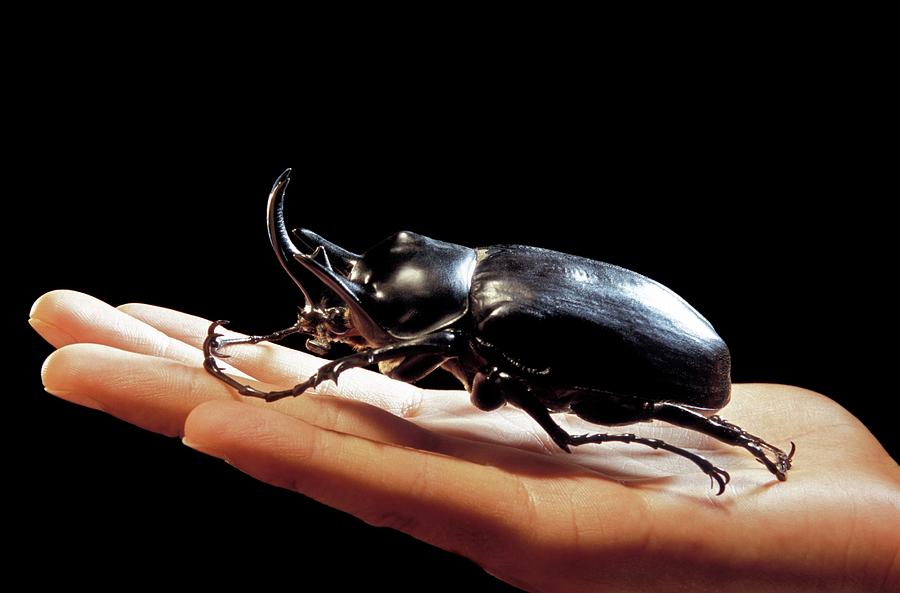
The heaviest insect on the Earth and the most powerful beetle of all known insect species. Its name Actaeon derives from the name of a hunter in Greek mythology. It can reach up to 13.7 cm in length, 4 cm in thickness and 6 cm in width. Adults can weigh 156g and larvae can weigh 240g. Adults are usually matte dark, and some could be dark brown. Males have well-developed head horns and two large thoracic horns protruding in the right and left. Females are small and black, usually only 6-8 cm long, with no horns and some rough granules in the center of elytra.
10. Giant Water Bug
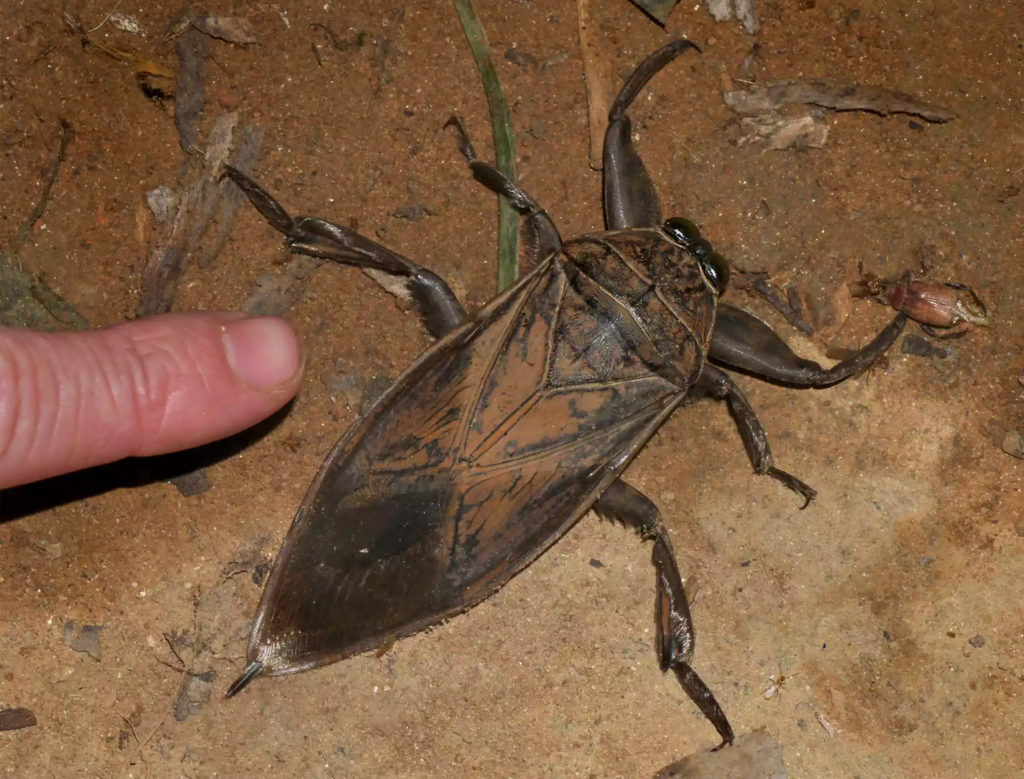
The heteropteran family Belostomatidae contains the giant water bugs. These large, predatory, aquatic insects have the largest body size among the Heteroptera. Adults of some South American species reach 4 inches in length. Individuals occur in ponds and ditches where they suspend below the surface, respiring through two abdominal appendages which act as siphons.
During mating season they fly from pond to pond or pool of water. It is during these flights that these insects fly to lights in large numbers, earning their other common name, “electric light bugs”. Individuals are capable of inflicting a painful bite with their strong beak, and may also pinch with their front legs. Individuals prey on aquatic insects, small fish, frogs, tadpoles, small birds, and other organisms they are able to capture. Powerful enzymes are injected into prey to kill them.
Adults of Lethocerus are considered a delicacy in Asia, and are eaten both fresh and cooked.
11. Hercules Beetle
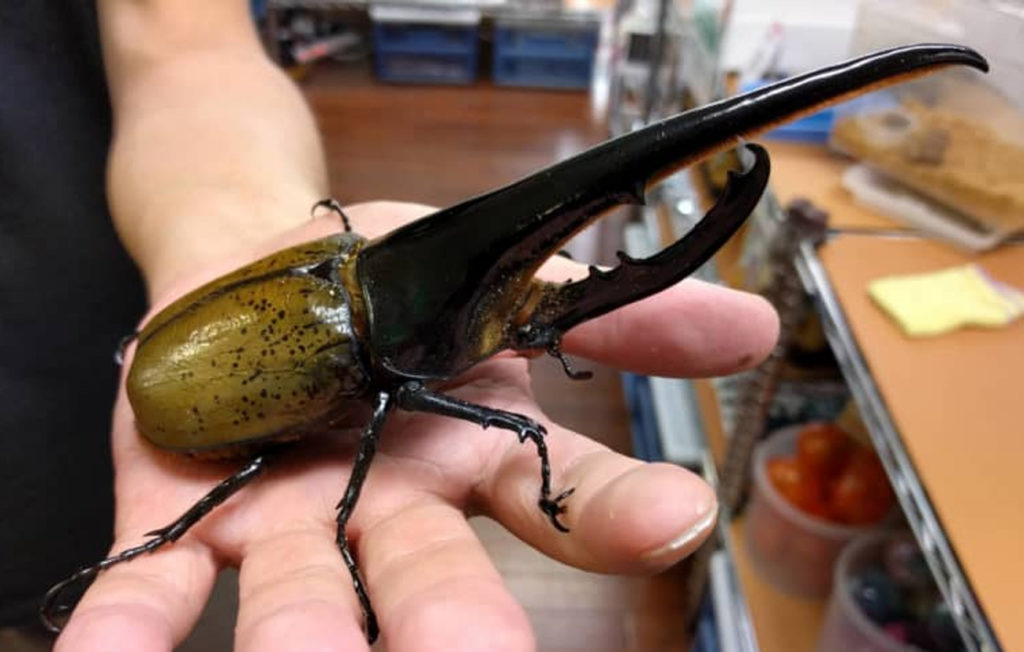
Named after the famous hero of Greek mythology, this enormous species of rhinoceros beetle hails from the rainforests of Central America, South America, and the Caribbean islands. The most prominent characteristic is the huge horn that extends from the thorax (as well as a second horn that emerges from the head) of the male beetle. The female completely lacks this unique accoutrement.
As a result, the male Hercules beetle can measure up to 7 inches long (depending on its nutritional intake and some environmental conditions), but the horn makes up nearly half of the entire body length and so it’s difficult to make direct comparisons to other types of insects. The beetle’s larval stage, which lasts about two years and features three different metamorphosis stages, can grow nearly 5 inches in length as well.
12. Mydas Flies

Members of the Mydas fly family tend to be large (for true flies), and many species resemble wasps (although they are harmless). Many species are black, dark, or tan, with red, orange, or yellow bands. Like all true flies, they only have only one pair of wings. Unlike most flies, they have clubbed antennae (rather like the antennae of butterflies). Each foot has two pads, and there are distinct aspects to the wing venation as well.
Similar species: Robber flies (family Asilidae), a closely allied group, look similar (for they too are large bee and wasp mimics), but they lack the clubbed antennae, and there are differences in wing venation, as well.There are many different insects that mimic bees and wasps, and there are many different bees and wasps for them to mimic! Keep in mind that members of the fly family have only two wings (one pair), while other insects (including the bee and wasp family) have four wings (two pairs). SizeLength: ¼ to 1¼ inches. Most are about 1 inch long. (Some tropical species, including the world’s largest fly, are more than 2 inches long.)
13. Giant Atlas Beetle
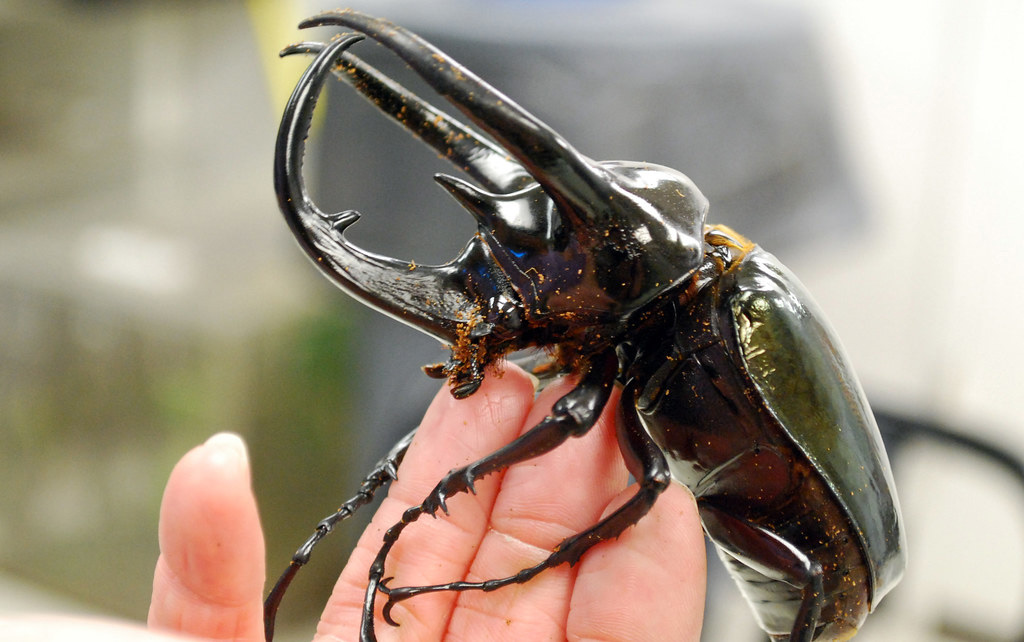
The Atlas beetle (Chalcosoma atlas) belongs to the family ‘Scarabaeidae’. The Atlas beetle is found in southern Asia, particularly Malaysia. It is remarkable for its size which can be between 25 and 145 millimetres. Like many insect species, the male is larger than the female and usually two males will fight for dominance, the winner permitted to mate with the female in question. The Atlas beetle is, like other beetles of the genus Chalcosoma, notable for its size and its horns that are located on its head. It is a very strong beetle and can carry 4 grams in weight. The Atlas beetle differs from other Chalcosoma species as its cephalic (relating to the head) horn is much broader.
One fascinating fact about the Atlas beetle is that its larvae is known for its fierce behaviour. The larvae is capable of biting, even if only touched. It is also known that larvae that live together will fight to the death if there is not enough space or food.
14. Giant grasshopper (Tropidacris cristata)
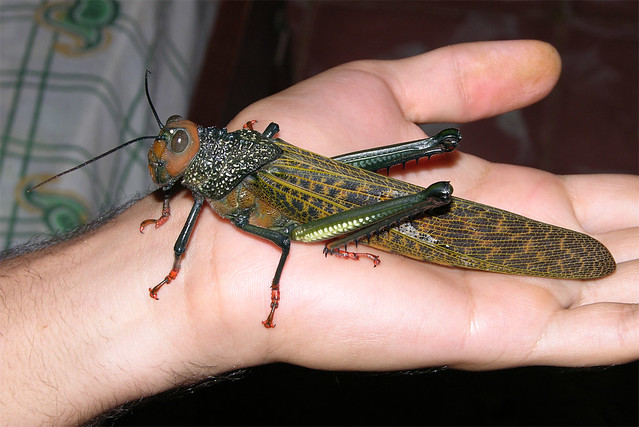
The giant grasshoppers (genus Tropidacris) of South and Central America have a body
length of about 10cm and a wingspan of about 18cm and are some of the largest insects in the
world (Carbonell, 1986). Two species, Tropidacris cristata and the similar Tropidacris collaris,
range within South America north of the southern cone. The name Tropidacris dux is also
sometimes used, but this now refers to a subspecies of T. cristata. Only T. cristata is found in
Trinidad, this species has mainly orange hindwings (Carbonell, 1984) (Fig. 2). T. collaris has
yellow antennae and green to blue hindwings. The nymphs (immature stages) show warning
coloration of black and yellow (Fig. 3) and are often found in groups, while the adults are well
camouflaged in vegetation. The forewings resemble leaves while the hindwings possess a striking
coloration (Rowell, 1983).
15. Giant Long-Legged Katydid
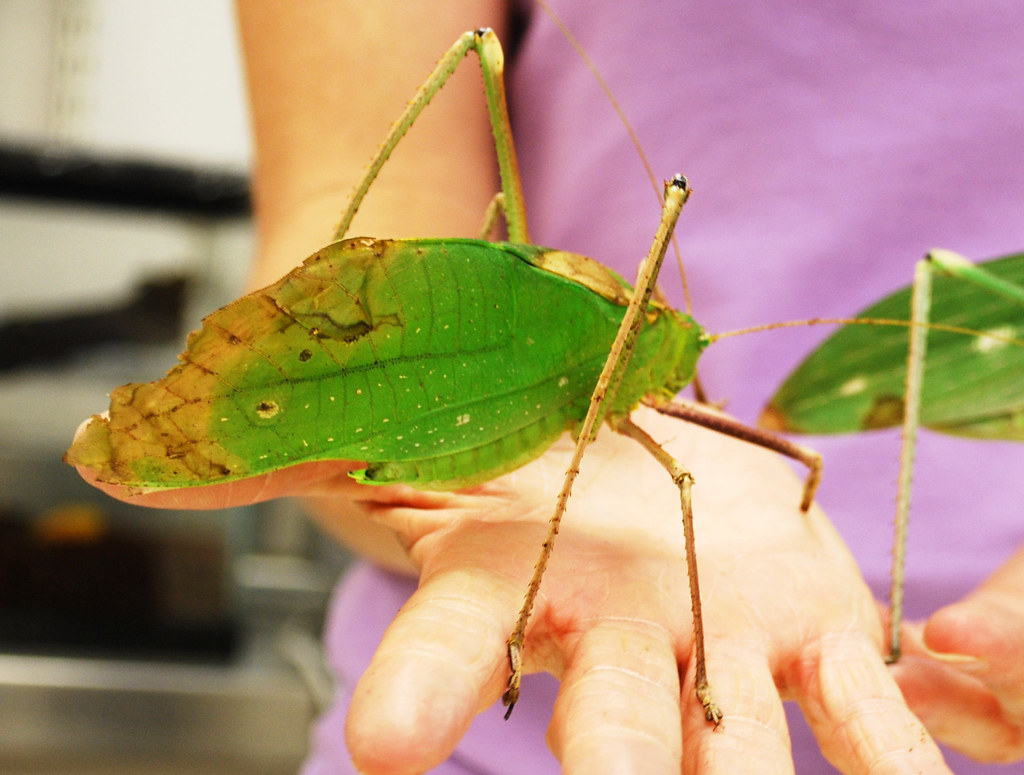
Giant katydids, Macrolyristes corporalis, may look a bit frightening, but they are very gentle! This is the largest species of katydid in the world. These incredible insects come from the forested mountain slopes of tropical Malaysia. During the day, they remain motionless and use their camouflage to avoid predators. At night, they use their long antennae to find food and look for a mate. The males produce an extremely loud, high pitched noise to call for a female.
Katydids are related to grasshoppers, so they look similar, but notice the long antennae and leaf-like appearance of the wings. These characteristics distinguish them from their grasshopper relatives, which have short antennae and wings folded flat over the back. This species of grasshopper can grow up to 13 centimetres (5.1 inches), but it can’t jump as far as its smaller counterparts. In fact, it can barely jump at all and it one of the easiest species to remove from crops and other food-stock. What is interesting is that many of them can perform mimicry and camouflage, commonly with shapes and colours similar to leaves.
Most katydids eat leaves, but some are predators that eat other small insects.
16. Peruvian giant yellow-leg centipede

Scolopendra gigantea, also known as the Peruvian giant yellow-leg centipede or Amazonian giant centipede, is one of the largest centipedes of the genus Scolopendra with a length up to 30 centimetres (12 in). This species is found in various places in South America and the Caribbean, where it preys on a great variety, including other sizable arthropods, amphibians, mammals and reptiles.
The Amazonian Giant Centipede has been observed eating bats, too. They do this by climbing the walls of caves. They grasp onto the bats with the front legs while using the back legs to secure themselves to the cave wall. Astonishingly, they’re able to hold on for prolonged periods, even while eating! Once secured, they inject prey with paralyzing-venom. Centipedes tend to hunt during the night, so, for this reason, they rarely come into contact with humans. Bites reportedly cause severe pain, local swelling and nausea, although death from bites is rare. In most cases, healthy individuals survive.
17. Enoplocerus armillatus (Giant Longhorn beetle): up to 15 cm (5.9 in)
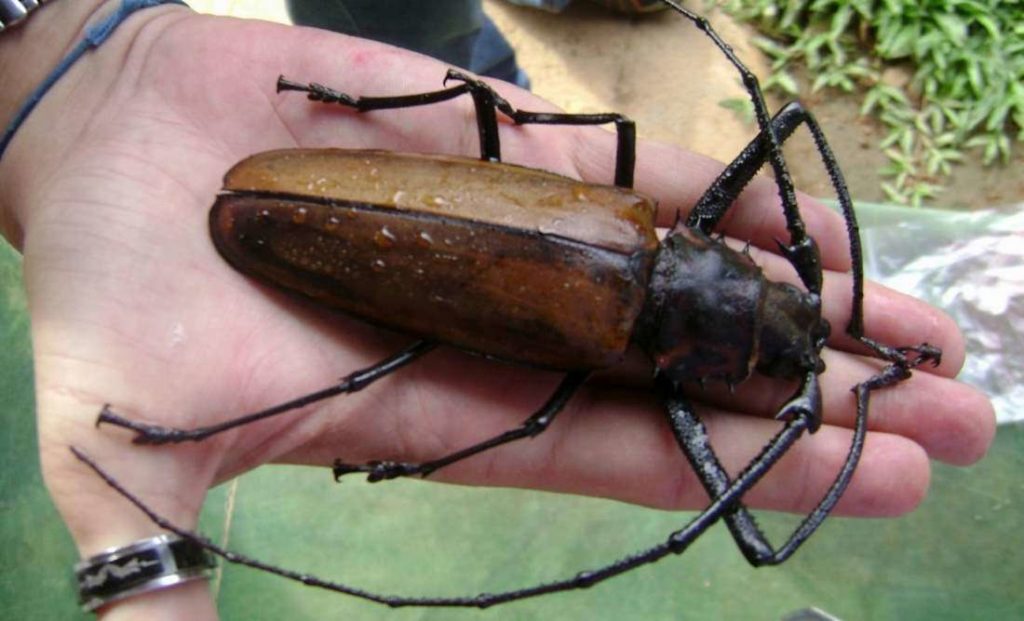
The females of the giant longhorn beetle reach a length of 70-80 millimeters (2.8-3.1 in) and males 110-120 millimeters (4.3-4.7 in), but specimens up to 150 millimeters (5.9 in) have been captured.
The giant longhorn beetle can be found in Argentina, Colombia, French Guiana, Guyana, Venezuela, Trinidad & Tobago, Ecuador, Peru, Brazil, Bolivia, Paraguay, Panama, and Suriname.
18. Macrodontia cervicornis (Sabertooth Longhorn beetle): up to 17+ cm (6.7+ in)
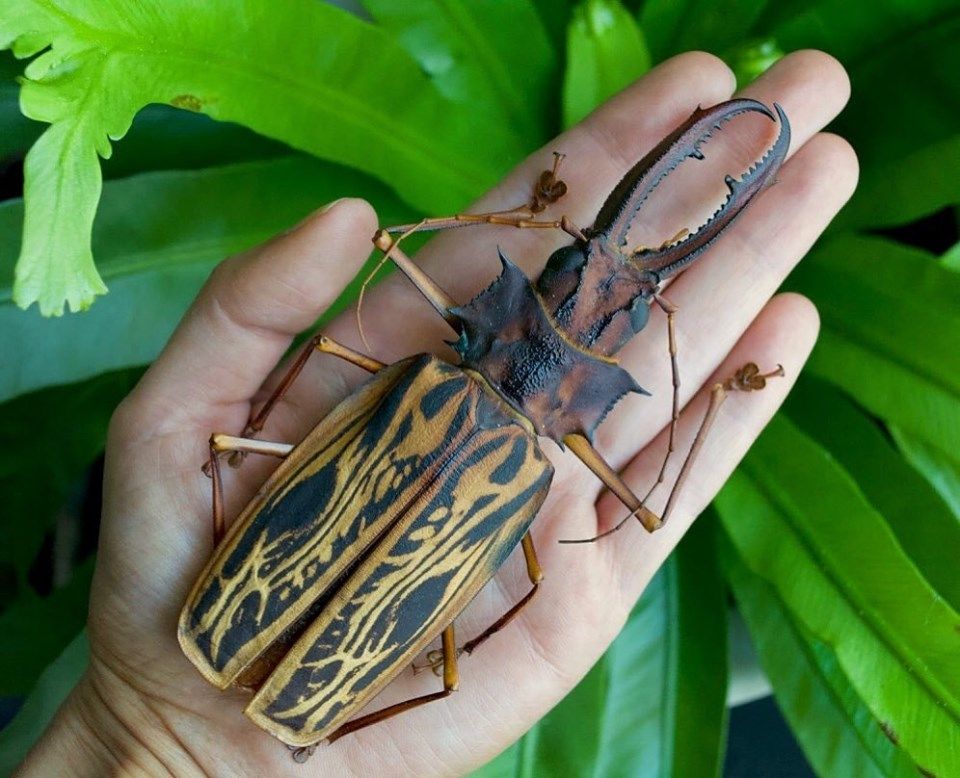
Macrodontia cervicornis is one of the largest beetles, with known specimens exceeding 17 cm in length. Part of this length is due to the enormous mandibles, from which it derives both of the names in its binomen: Macrodontia means “long tooth”, and cervicornis means “deer antler”.
It is also known as the “Sabertooth Longhorn beetle”. Most of this species’ life is spent in the larval stage, which can last up to 10 years, and the larvae of M. cervicornis are extremely large, reaching up to 21 cm in length.
Macrodontia cervicornis is known from the rain forests of Colombia, Ecuador, Peru, Bolivia, the Guianas, and Brazil. Additional described species in the genus extend the overall range of the genus from Guatemala to Argentina.
19. Giant Praying Mantis
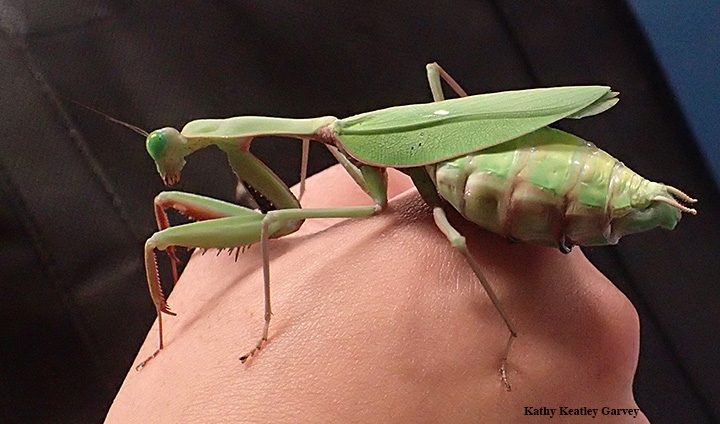
The world’s largest praying mantis was recorded at about 18 centimeters long, in Southern China, in 1929. According to Wikipedia, they can reach lengths of 20 cm.
As an apex carnivorous insect, the praying mantis feeds mainly on other insects. It is, however, documented that larger praying mantises are able to consume small reptiles and even small mammals or birds.
20. Asian giant hornet (Vespa mandarinia)
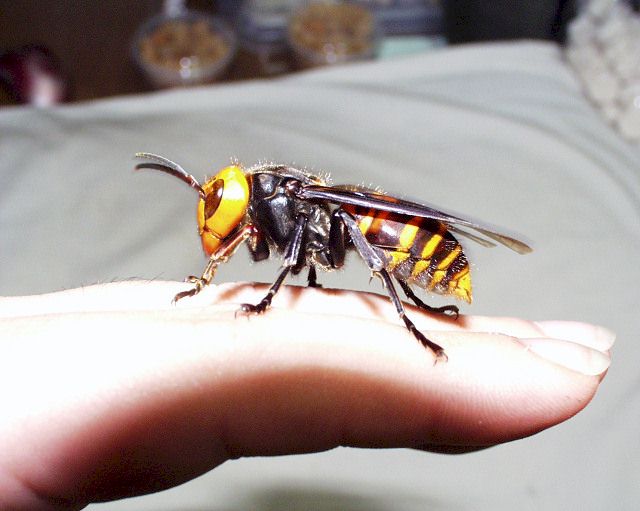
The Asian giant hornet (Vespa mandarinia), including the color form referred to as the Japanese giant hornet, is the world’s largest hornet. It is native to temperate and tropical East Asia, South Asia, Mainland Southeast Asia, and parts of the Russian Far East. It was also found in the Pacific Northwest of North America in late 2019 with a few more additional sightings in 2020, prompting concern that it could become an invasive species.
They prefer to live in low mountains and forests, while almost completely avoiding plains and high-altitude climates. V. mandarinia creates nests by digging, co-opting pre-existing tunnels dug by rodents, or occupying spaces near rotted pine roots. It feeds primarily on larger insects, colonies of other eusocial insects, tree sap, and honey from honey bee colonies.
The hornet has a body length of 45 millimetres (1+3⁄4 inches), a wingspan around 75 mm (3 in), and a stinger 6 mm (1⁄4 in) long, which injects a large amount of potent venom. Although the scientific literature and official government sources continue to refer to this species by its established common name, the mainstream media have taken to using the nickname “murder hornet”.
Read Latest articles:
- Silent Killers of the Sea: Fishing Nets and the Devastating Impact on Our Oceans
- Amazing Ability of Sharks to Regrow Their Dorsal Fins
- Mountain Marvels: 7 Architectural Wonders Built into Nature’s Slopes
- The Frilled Shark: Jaws of the Abyss and a Living Fossil
- 30 Christmas Rock Painting Ideas – Last minute DIY crafts for Christmas decor, gifts and stocking fillers

